| Botanical Name |
|
| Family |
Crassulaceae - The crassula family. |
| Pronunciation |
|
| Common Name(s) |
English: Kerky Bush; Pink Joy; Jade Plant
USA: Money Tree; Penny Plant; Dollar Plant; Tree of Happiness
|
| Plant Group |
- Succulent A plant having fleshy stems or leaves often adapted to dry conditions.
|
| Plant Size |
- Very large
| Tree | Over 25m |
| Shrub | Over 4m |
| Perennial/ground cover | Over 1m |
| Bulb | Over 1.2m |
| Succulent | 1.5m to 2m |
|
| Position |
- Partial Shade The area is in shade for part of the day and in full sun for part of the day.
- Sun The area is in full sun for all or most of the day, all year round.
|
| General Information |
- Drought Tolerance: High The plant is well adapted to arid conditions; it can survive long periods of drought and high temperatures without extra water.
- Evergreen Plants that have leaves all year round.
- Frost: Half-hardy The plant is able to survive low temperatures and some frost but requires protection against severe frost.
- Sand tolerant Plants adapted to survive in nutrient poor, very sandy soils.
- Water Wise Plant species originating from low rainfall regions that require less water to survive and thrive than other plant species.
- Wind Tolerant Plants able to withstand the effect of strong winds.
|
| Specific Information |
Crassula ovata is a sturdy, branched, compact, rounded, evergreen succulent shrub growing from 1 - 3 m tall. It has glossy, dark- to grey-green oval leaves, short, stubby branches and a robust stem or trunk. The leaves are often edged with red, more so if the plant is in full sun. Flowering time varies according to climate. The stems soon become gnarled and stout, suggesting great age.
The Jade plant is grown all over the world, most often as a pot plant. It has been cultivated as a plant bringing financial good luck, giving rise to the common names Money Tree, Penny Plant, Dollar Plant and Tree of Happiness.
|
| Ad Break |
|
| Flowers |
| Description |
a profusion of tiny star flowers in tight, round heads
|
| Season |
- Winter to Summer Plants will seldom bloom for the entire season as given in the list, but should flower during a period within these parameters.
|
| Colour |
|
| Growth Rate |
- Fast Specifying growth rate can be very misleading as there is considerable variation of growth rate depending on type and species of plant, available water, supplementary feeding, mulching and general care, as well as the plants suitability and adaptability to the garden environment.
|
| Plant Uses |
- Accent or Focal Point A plant used to attract the attention because of its colour or form.
- Attracts bees, butterflies or other insects This plant attracts insects which can be food for birds or other creatures in your garden.
- Attracts Birds This plant will attract birds.
- Border A strip of ground, at the edge of a driveway or path in which ornamental plants or shrubs are planted.
- Boundary A plant useful for planting around the edges of the property to form a green or colourful backdrop, an impenetrable hedge, to hide walls or create privacy.
- Container Trees, shrubs and ornamental species that can adapt to growing in a restricted environment.
- Filler Either a fast growing tree or shrub used temporarily to fill in an area while the permanent plants grow to a desired size, or a plant used to fill gaps in borders or beds.
- Hedge Suitable trees or shrubs planted relatively close together so that the branches intertwine to create a barrier. This can be formal – the plants are regularly trimmed to produce a neat shape, or informal – the plants are left to themselves to create a natural hedgerow.
- Pioneer for new gardens A very fast growing plant, able to withstand hardship, that can be used to populate land that has recently been cleared of natural vegetation. These plants pave the way for slower-growing species by adding nutrients to the soil and creating leaf litter.
- Pot Plant A plant that needs a protected environment on a patio or indoors.
- Rock Garden An area constructed of larger rocks, arranged naturally, to emphasise the use of stones as a main element. Generally plants used do not need a lot of care.
- Suitable for coastal gardens Plants adapted to dry, sandy soil, forceful wind, limited rainfall and intense sunlight.
- Suitable for smaller gardens Such plants do not have invasive root systems, remain small or controllable and can often be grown in containers.
- Wild Garden An indigenous garden planted for the benefit of wildlife and birds. Provides food, water, a variety of mini-biomes and no poisonous chemicals are used.
|
| Distribution and Habitat |
in the Eastern Cape and KwaZulu-Natal, in valley thicket and on rocky hillsides
|
| Planting Suggestions |
Grow in normal loam soil with good drainage. It thrives in semi-shade, but will flower best in a sunny position. Feed with compost and fertiliser for fast, lush growth. Rather under water than over water. A kerky bush with wet feet will soon rot and die, but can withstand severe, long term drought. Protect from frost to prevent the flowers from being damaged. Crassula ovata is easy to propagate from stems and leaves, which should be kept relatively dry to prevent rot.
|
| Medicinal Uses |
The roots, grated, cooked and combined with thick milk were eaten by the Khoi and other African tribes. The leaves were boiled in milk and used to treat epilepsy and corns, as a purgative and as a remedy for diarrhoea, .
|
| Ad Break |
|


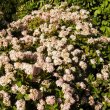

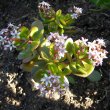
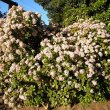
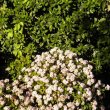
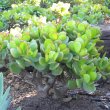
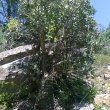


Comments
Crassula Ovata
Hi
I am a curious student of agriculture with strong belief in natural healing plants. I would like to ask how you use crassula leaves boiled in milk to treat epilepsy.
I understand that you are not a doctor will not hold you responsible for anything - just need further knowledge.
Thank you in Advance
Nicholas Zungu
Crassula Ovata - medicinal use
Hi Nicholas
I have had no training in the medicinal use of plants. There is very little information available about exactly how these plants are used. This information is often closely guarded and available only to those involved in traditional healing. A Traditional Healer living in the areas where this plant grows naturally may be able to enlighten you.
Kind regards
Lorraine
Discuss this plant
Share knowledge, ask a question or give an experience.